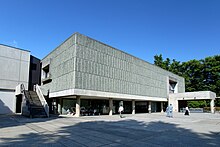Ueno
This article has multiple issues. Please help improve it or discuss these issues on the talk page. (Learn how and when to remove these messages)
|




Ueno (上野) is a district in Tokyo's Taitō Ward, best known as the home of Ueno Park. Ueno is also home to some of Tokyo's finest cultural sites, including the Tokyo National Museum, the National Museum of Western Art, and the National Museum of Nature and Science, as well as a major public concert hall. Many Buddhist temples are in the area, including the Bentendo temple dedicated to goddess Benzaiten, on an island in Shinobazu Pond. The Kan'ei-ji, a major temple of the Tokugawa shōguns, stood in this area, and its pagoda is now within the grounds of the Ueno Zoo. Nearby is the Ueno Tōshō-gū, a Shinto shrine dedicated to Tokugawa Ieyasu. Near the Tokyo National Museum there is The International Library of Children's Literature. Just south of the station is the Ameya-yokochō, a street market district that evolved out of an open-air black market that sprung up after World War II. Just east is the Ueno motorcycle district, with English-speaking staff available in some stores.
Ueno is part of the historical Shitamachi (literally "low city") district of Tokyo, a working class area rather than where the aristocrats and rich merchants lived. Today the immediate area, due to its close proximity to a major transportation hub, retains high land value but just a short walk away to the east or north reveals some of the less glitzy architecture of Tokyo.
Ueno Station is the nearest train station and is operated by JR East.
Ueno Park and Ueno Station are also home to a large percentage of Tokyo's homeless population. Though nearly invisible in other parts of Tokyo, the homeless population in Ueno can be found sleeping or communing in large numbers around the "ike" (ponds) of this district.
Economy
Ueno is the hometown of Yoshida Watch Shop, established in 1901 by Shogoro Yoshida. It is the origin of Orient Watch Co., Ltd.[1]
Education

Public high schools are operated by the Tokyo Metropolitan Government Board of Education.
Taito City Board of Education operates public elementary and junior high schools.
Ueno 1-4 and 6-chome and part of Ueno 5-chome are zoned to Kuromon Elementary School (黒門小学校). Ueno 7-chome is zoned to Ueno Elementary School (上野小学校). A portion of Ueno 5-chome is zoned to Heisei Elementary School (平成小学校).[2]
Ueno 1-2 chome is zoned to Ueno Junior High School (上野中学校). Ueno 4 and 7-chome and portions of 3 and 5-6-chome are zoned to Shinobugaoka Junior High School (忍岡中学校). Parts of Ueno 3 and 5-6 chome are zoned to Okachimachi Taito Junior High School (御徒町台東中学校).[3]
Private schools:
-
Kuromon Elementary School (黒門小学校) - 1-chome
Public transport
 JU JK JY JJ G H Ueno Station
JU JK JY JJ G H Ueno Station- JK JY Okachimachi Station
- G Ueno-hirokoji Station
- E Ueno-okachimachi Station
- H Naka-okachimachi Station
- C Yushima Station
- KS Keisei Ueno Station
See also
References
- ^ Orient Watch History Archived 2012-01-10 at the Wayback Machine, (in Japanese). Retrieved 3 October 2014
- ^ "台東区立小学校通学区域表" (PDF). City of Taito. Retrieved 9 October 2022.
- ^ "台東区立中学校通学区域表" (PDF). City of Taito. Retrieved 9 October 2022.
External links
 Ueno travel guide from Wikivoyage
Ueno travel guide from Wikivoyage- Ueno / Official Tokyo Travel Guide GO TOKYO


